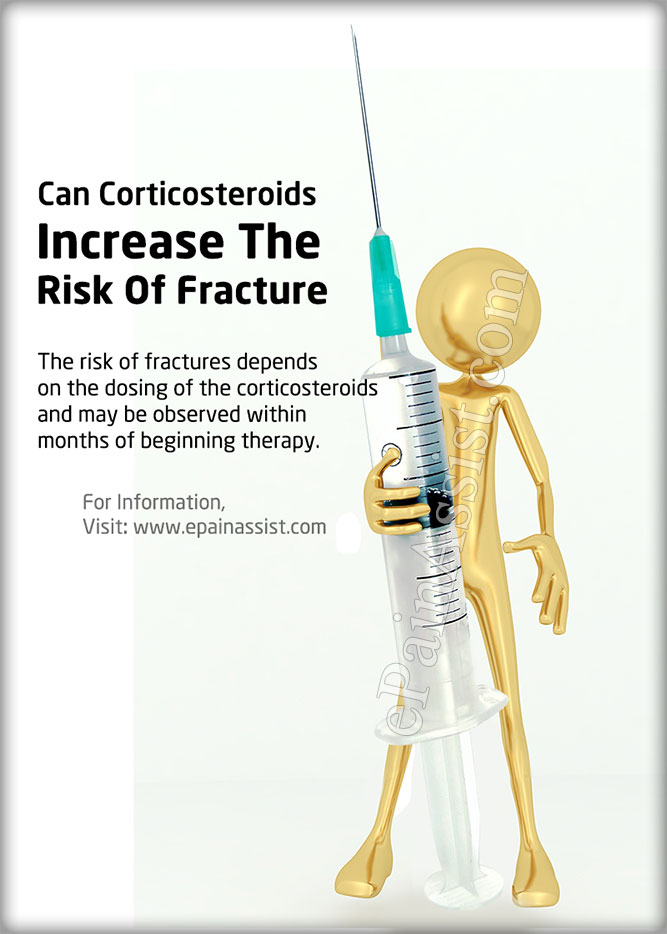How Does Corticosteroid Administration Increase The Risk Of Fractures?
Corticosteroids have been known to increase the risk of fractures as they tend to reduce bone formation and functionality of osteoblasts and osteocytes. The risk of fractures depends on the dosing of the corticosteroids and may be observed within months of beginning therapy.1 If an individual is taking around 2.5 mg of prednisone on a daily basis, then the risk of fracture for that individual increases significantly. Some studies have revealed adverse effects on the bone even with low doses of corticosteroids. As soon as the treatment is over, the risk of fracture falls steeply. Hence it is recommended that people on steroid therapy take adequate calcium and vitamin D supplements to keep the bones strong. Individuals with much higher risk of fractures are also recommended bisphosphonates.

What Role Does Corticosteroids Play In Increasing The Risk Of Fractures?
Bone loss due to corticosteroid therapy is highest in the vertebral bodies along with bones of the ribs, and distal radius but bone loss may also occur in the femur. It is not fully known when it comes to the mechanism as to why there is bone loss due to corticosteroids, but research suggests the inhibitory effects of corticosteroids on osteoblasts is the primary reason. Corticosteroid slows down the replacement of osteoblasts and also reduces synthesis of bone collagen, which results in decreased bone replacement causing the bone to become weak and fracture easily. Corticosteroids also reduce calcium absorption and increase calcium excretion further contributing to bone loss, but these adverse effects can be completely reversed if the individual is on adequate supplements of calcium with vitamin D.
What Role Does The Dosage And Timing Of Corticosteroids Play In Increasing The Risk Of Fractures?
Some studies reflect that everyday dosing of corticosteroids significantly decrease bone formation. Thus chronic daily doses of corticosteroids are to blame for decreased bone formation and increasing bone fragility, although daily dosing is more responsible for bone loss rather than the duration of the dosing. The rate at which the bone loss occurs is most remarkable in the first six months of starting steroid therapy but the rate of bone loss tends to slow down with tapering of the steroids.
Intermittent use of oral corticosteroids and inhaled forms of corticosteroids increase risk of vertebral fractures, although the risk is relatively less than compared to chronic dosing of steroids.
Why Is It Important To Assess The Risk Of Fractures When Starting Corticosteroids In A Patient?
It is the duty of the physician to assess the risk of fracture in a patient before beginning corticosteroid therapy. Some of the factors which need to be taken into account are the dosing, underlying medical condition, age, female gender, menopausal status, and bone mineral density of the individual. Postmenopausal females are at highest risk of sustaining fractures due to corticosteroid administration. The effects of steroids on the bone mineral density of an individual can be accurately measured using dual energy X-ray absorptiometry.
How Can The Risk Of Fractures Be Reduced While Administering Corticosteroids?
The best way to prevent the risk of fractures due to corticosteroids is by using steroids for a short period of time and not chronically. Apart from this, when on corticosteroids, adequate supplements of calcium and vitamin D should be taken to keep the bones strong. During therapy, individual should abstain from smoking and consuming alcohol. Apart from the above medications like calcidiol, Alfacalcidiol have been shown to be helpful when taken along with calcium.
